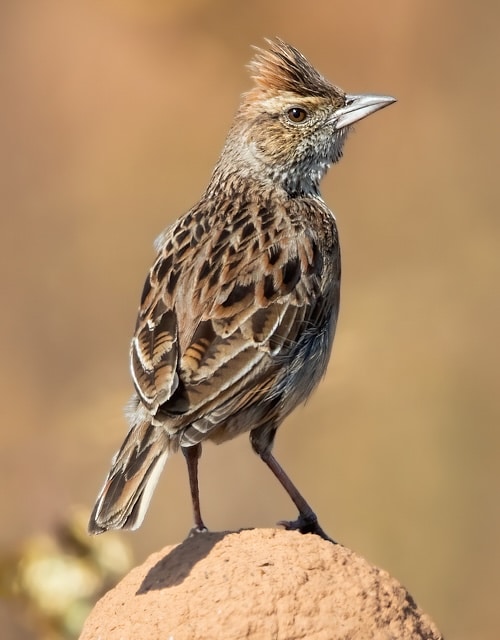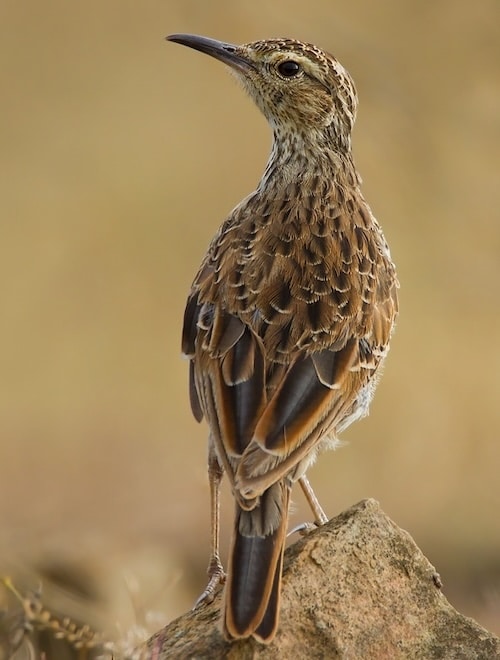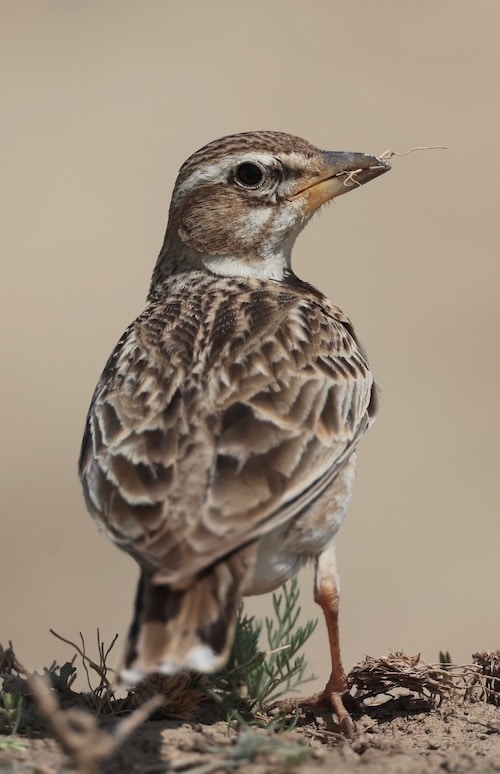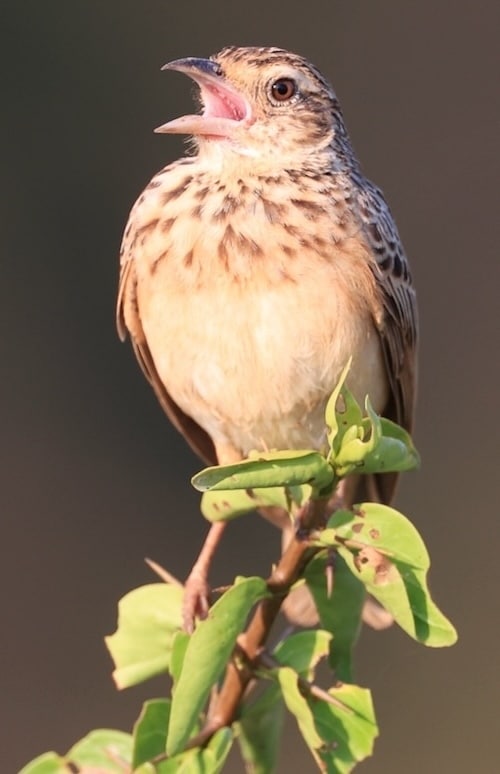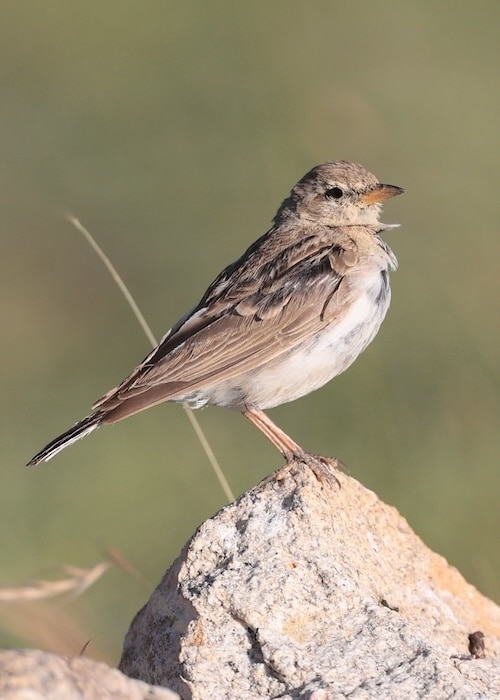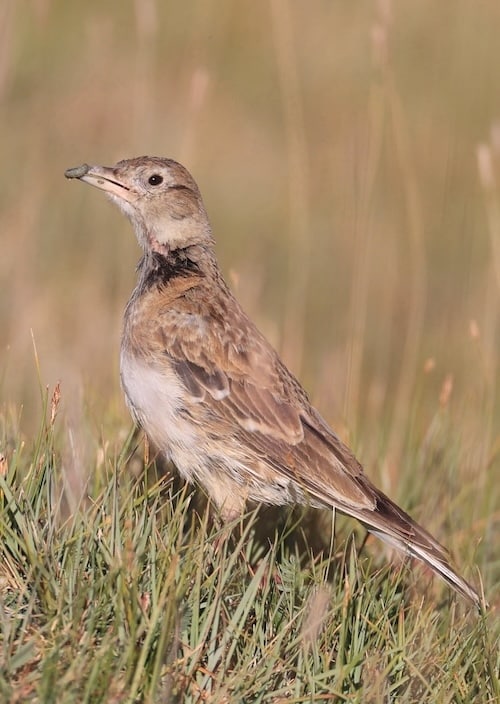Alaudidae – Larks
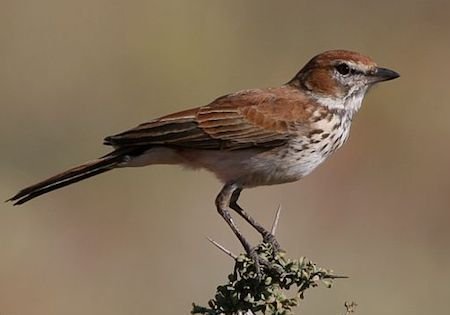
Alaudidae (Larks) are passerine. Larks have a cosmopolitan distribution with the largest number of species occurring in Africa. Only a single species, the Horned (Shore) Lark, occurs in North America, and only Singing Bush Lark occurs in Australia. Habitats vary widely, but many species live in drier regions. When the word ‘lark’ is used without specification, it most often refers to the Eurasian Skylark Alauda arvensis.
Larks are small to medium-sized birds, 12 to 24cm in length and 15 to 75g in mass. They have more elaborate calls than most birds, and often extravagant songs given in display flight. These melodious sounds (to human ears), combined with a willingness to expand into anthropogenic habitats, as long as these are not too intensively managed, have ensured larks a prominent place in literature and music, especially the Eurasian Skylark in northern Europe and the Crested Lark and Calandra Lark in southern Europe.
|
|
|
|
Angolan Lark Amirafra angolensis |
Cape Long-billed Lark Certhilauda curvirostris |
|
All photographs in this text (unless otherwise attributed) courtesy of ©Dubi Shapiro |
|
With these song flights, males defend their breeding territories and attract mates. Males in some species have larger wings, perhaps to allow them to make these repeated song-flights more efficiently, and in some species males and females have bills of different lengths, associated with slight differences in diet and foraging tactics.
|
|
|
|
Bimaculated Lark Melanocorypha bimaculata |
Jerdon’s Bush Lark Plocealauda affinis |
|
|
|
|
Hume’s Short-toed Lark Calandrella acutirostris |
Tibetan Lark Melanocorypha maxima |
|
The above four photographs courtesy of ©Nick Ludovic Green Bird-Photo-Tours ASIA |
|
Most species build nests on the ground, usually cups of dead grass, but in some species the nests are more complicated and partly domed. A few desert species nest very low in bushes, perhaps so circulating air can cool the nest. Larks’ eggs are usually speckled, and clutch sizes range from two (especially in species of the driest deserts) to six (in species of temperate regions). Larks incubate for 11 to 16 days.

Temminck’s Lark Eremophila bilopha
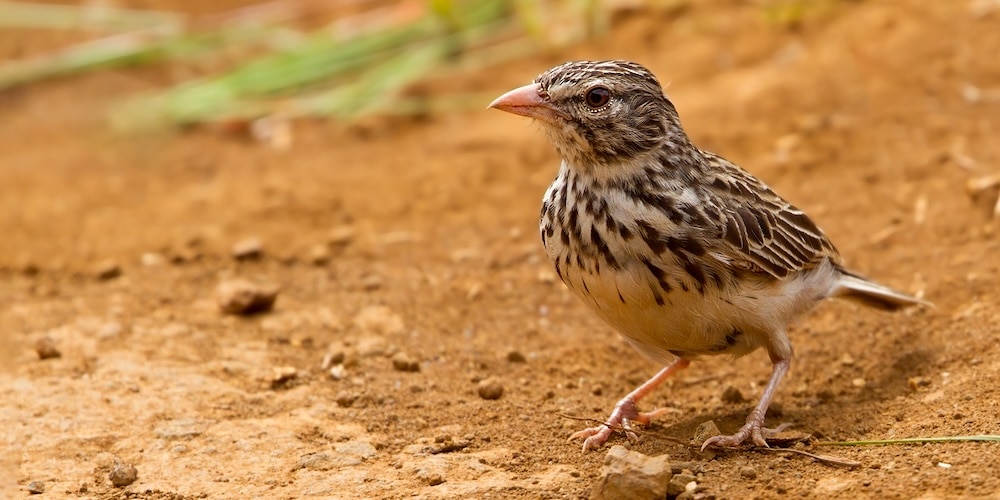
Madagascan Lark Eremopterix hova
Like many ground birds, most lark species have long hind claws, which are thought to provide stability while standing. Most have streaked brown plumage; some boldly marked with black or white. Their dull appearance camouflages them on the ground, especially when on the nest. They feed on insects and seeds; though adults of most species eat seeds primarily, all species feed their young insects for at least the first week after hatching. Many species dig with their bills to uncover food. Some larks have heavy bills (reaching an extreme in the thick-billed lark) for cracking seeds open, while others have long, down-curved bills, which are especially suitable for digging.
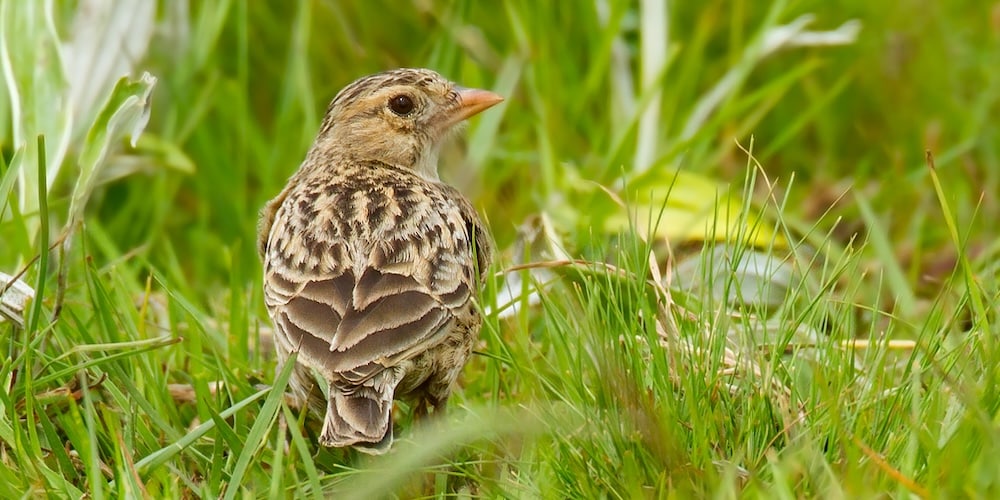
Botha’s Lark Spizocorys fringillaris
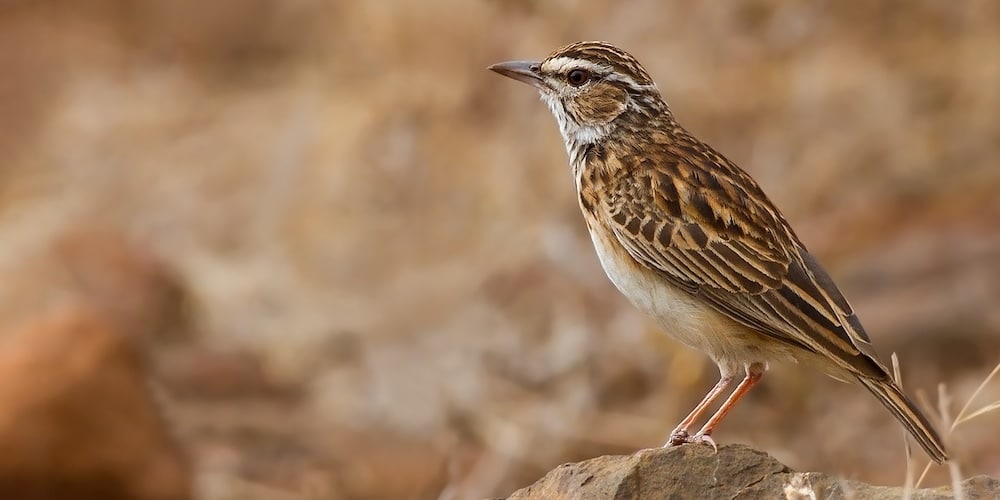
Sabota Lark Calendulauda sabota
They are the only passerines that lose all their feathers in their first moult (in all species whose first moult is known). This may result from the poor quality of the chicks’ feathers, which in turn may result from the benefits to the parents of switching the young to a lower-quality diet (seeds), which requires less work from the parents.
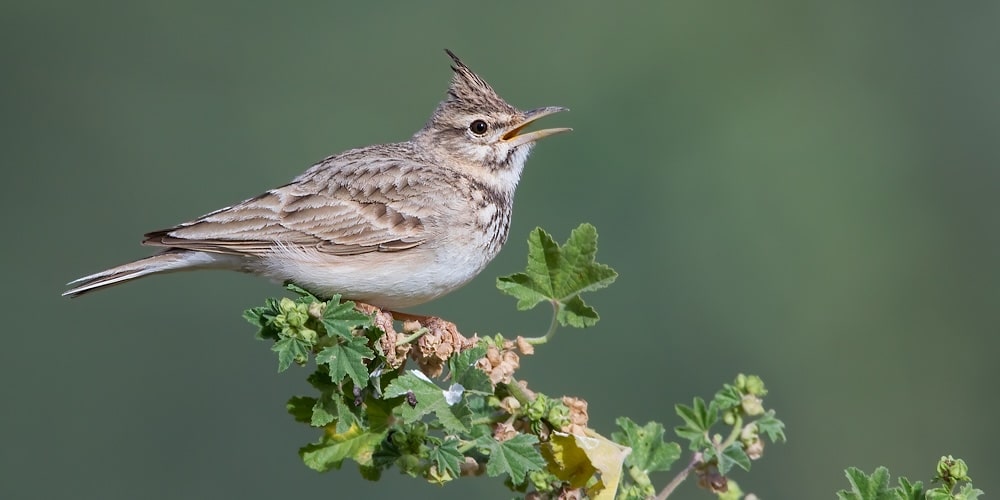
Crested Lark Galerida cristata
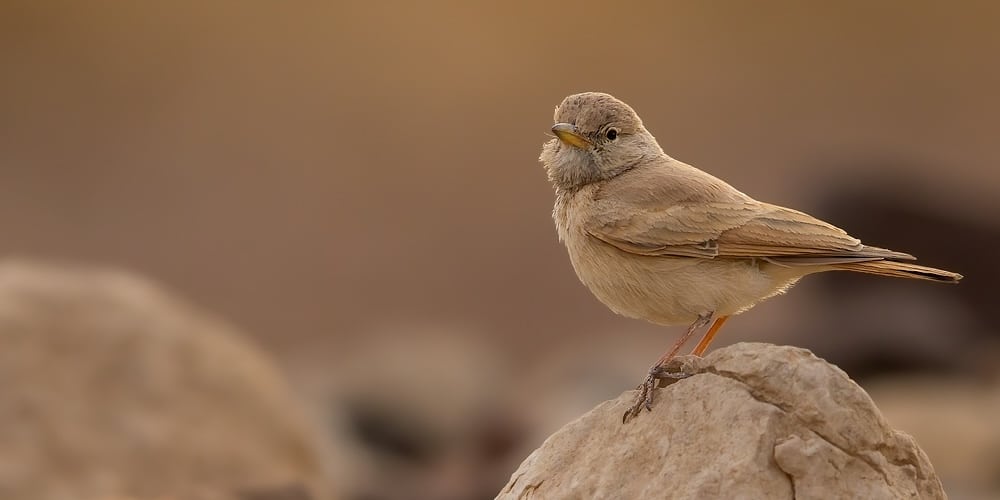
Desert Lark Ammomanes deserti
In many respects, including long tertial feathers, larks resemble other ground birds such as pipits. However, in larks the tarsus (the lowest leg bone, connected to the toes) has only one set of scales on the rear surface, which is rounded. Pipits and all other songbirds have two plates of scales on the rear surface, which meet at a protruding rear edge.
-
Number of bird species: 98
(As at November 2025)
According to the recently (2025) amalgamated AviList, there are ninety-eight species, in twenty-four genera in the Alaudidae family. They are:
Lesser Hoopoe-Lark Alaemon hamertoni
Greater Hoopoe-Lark Alaemon alaudipes
Gray’s Lark Ammomanopsis grayi
Beesley’s Lark Chersomanes beesleyi
Spike-heeled Lark Chersomanes albofasciata
Short-clawed Lark Certhilauda chuana
Karoo Long-billed Lark Certhilauda subcoronata
Eastern Long-billed Lark Certhilauda semitorquata
Cape Long-billed Lark Certhilauda curvirostris
Rufous-rumped Lark Pinarocorys erythropygia
Dusky Lark Pinarocorys nigricans
Thick-billed Lark Ramphocoris clotbey
Bar-tailed Lark Ammomanes cinctura
Rufous-tailed Lark Ammomanes phoenicura
Desert Lark Ammomanes deserti
Black-eared Sparrow-Lark Eremopterix australis
Madagascan Lark Eremopterix hova
Grey-backed Sparrow-Lark Eremopterix verticalis
Fischer’s Sparrow-Lark Eremopterix leucopareia
Chestnut-headed Sparrow-Lark Eremopterix signatus
Black-crowned Sparrow-Lark Eremopterix nigriceps
Ashy-crowned Sparrow-Lark Eremopterix griseus
Chestnut-backed Sparrow-Lark Eremopterix leucotis
Rusty Bush Lark Calendulauda rufa
Sabota Lark Calendulauda sabota
Gillett’s Lark Calendulauda gilletti
Pink-breasted Lark Calendulauda poecilosterna
Fawn-colored Lark Calendulauda africanoides
Karoo Lark Calendulauda albescens
Red Lark Calendulauda burra
Dune Lark Calendulauda erythrochlamys
Rudd’s Lark Heteromirafra ruddi
Archer’s Lark Heteromirafra archeri
Burmese Bush Lark Plocealauda microptera
Indochinese Bush Lark Plocealauda erythrocephala
Jerdon’s Bush Lark Plocealauda affinis
Indian Bush Lark Plocealauda erythroptera
Bengal Bush Lark Plocealauda assamica
Monotonous Lark Mirafra passerina
Kordofan Lark Mirafra cordofanica
Williams’s Lark Mirafra williamsi
Friedmann’s Lark Mirafra pulpa
White-tailed Lark Mirafra albicauda
Melodious Lark Mirafra cheniana
Singing Bush Lark Mirafra javanica
Collared Lark Amirafra collaris
Flappet Lark Amirafra rufocinnamomea
Angolan Lark Amirafra angolensis
Highland Lark Corypha kurrae
Cape Clapper Lark Corypha apiata
Eastern Clapper Lark Corypha fasciolata
Plains Lark Corypha kabalii
Plateau Lark Corypha nigrescens
Rufous-naped Lark Corypha africana
Sentinel Lark Corypha athi
Somali Lark Corypha somalica
Red-winged Lark Corypha hypermetra
Russet Lark Corypha sharpii
Kidepo Lark Corypha kidepoensis
Woodlark Lullula arborea
Stark’s Lark Spizocorys starki
Masked Lark Spizocorys personata
Pink-billed Lark Spizocorys conirostris
Botha’s Lark Spizocorys fringillaris
Short-tailed Lark Spizocorys fremantlii
Obbia Lark Spizocorys obbiensis
Sclater’s Lark Spizocorys sclateri
White-winged Lark Alauda leucoptera
Raso Lark Alauda razae
Oriental Skylark Alauda gulgula
Eurasian Skylark Alauda arvensis
Large-billed Lark Galerida magnirostris
Sun Lark Galerida modesta
Sykes’s Lark Galerida deva
Thekla Lark Galerida theklae
Malabar Lark Galerida malabarica
Crested Lark Galerida cristata
Temminck’s Lark Eremophila bilopha
Horned Lark Eremophila alpestris
Blanford’s Lark Calandrella blanfordi
Rufous-capped Lark Calandrella eremica
Greater Short-toed Lark Calandrella brachydactyla
Red-capped Lark Calandrella cinerea
Mongolian Short-toed Lark Calandrella dukhunensis
Hume’s Short-toed Lark Calandrella acutirostris
Bimaculated Lark Melanocorypha bimaculata
Mongolian Lark Melanocorypha mongolica
Tibetan Lark Melanocorypha maxima
Black Lark Melanocorypha yeltoniensis
Calandra Lark Melanocorypha calandra
Dupont’s Lark Chersophilus duponti
Dunn’s Lark Eremalauda dunni
Arabian Lark Eremalauda eremodites
Somali Short-toed Lark Alaudala somalica
Asian Short-toed Lark Alaudala cheleensis
Lesser Short-toed Lark Alaudala rufescens
Sand Lark Alaudala raytal
Turkestan Short-toed Lark Alaudala
-
British Larks, Pipits and Wagtails
| By Ertic Simms | HarperCollins | 2009 | Hardback | 320 pages, 4 plates with colour illustrations; 172 b/w photos, illustrations and maps | ISBN: 9780007308538 Buy this book from NHBS.com -
The Skylark
| By Paul F Donald | Poyser | 2004 | Hardback | 256 pages, Col photos, line illus, figs | ISBN: 9780713665680 Buy this book from NHBS.com -
The Soaring Life of the Lark
| By John Lewis-Stempel | Doubleday | 2021 | Hardback | 97 pages, b/w illustrations | ISBN: 9780857525802 Buy this book from NHBS.com
-
Alaudidae
Family AccountLarks live in just about every open habitat in their range, including open grassland, savanna, desert sand dunes and scrub, tundra, and agricultural fields. -
Alaudidae
Family AccountLarks are passerine birds of the family Alaudidae. Larks have a cosmopolitan distribution with the largest number of species occurring in Africa. Only a single species, the horned lark, occurs in North America, and only Horsfield's bush lark occurs in Australia.
Given the number of species in this family, Fatbirder does not provide quick links to all of them. However, the entries below do include links to representatives of every genera, all those illustrated and some of the most often encountered, iconic or sought-after species.
-
Angolan Lark Amirafra angolensis
Species AccountThe Angola lark (Amirafra angolensis) or Angola bushlark is a species of lark in the family Alaudidae found in southern and central Africa. -
Angolan Lark Amirafra angolensis
Species AccountSound archive and distribution map. -
Bimaculated Lark Melanocorypha bimaculata
Species AccountThe bimaculated lark (Melanocorypha bimaculata) breeds in warm temperate countries eastwards from Turkey into Central Asia. -
Bimaculated Lark Melanocorypha bimaculata
Species AccountSound archive and distribution map. -
Botha's Lark Spizocorys fringillaris
Species AccountBotha's lark (Spizocorys fringillaris) is a species of lark in the family Alaudidae that is endemic to South Africa. -
Botha's Lark Spizocorys fringillaris
Species AccountSound archive and distribution map. -
Calandra Lark Melanocorypha calandra
Species AccountThe calandra lark (Melanocorypha calandra) or European calandra-lark breeds in warm temperate countries around the Mediterranean and eastwards... -
Calandra Lark Melanocorypha calandra
Species AccountSound archive and distribution map. -
Cape Long-billed Lark Certhilauda curvirostris
Species AccountA large, slender lark with a long, thin decurved bill and long legs. -
Cape Long-billed Lark Certhilauda curvirostris
Species AccountSound archive and distribution map. -
Crested Lark Galerida cristata
Species AccountMedium sized lark with a prominent crest. Separated from the more range-restricted Thekla's Lark by longer bill... -
Crested Lark Galerida cristata
Species AccountSound archive and distribution map. -
Desert Lark Ammomanes deserti
Species AccountThe desert lark (Ammomanes deserti) breeds in deserts and semi-deserts from Morocco to western India -
Desert Lark Ammomanes deserti
Species AccountSound archive and distribution map. -
Dunn's Lark Eremalauda dunni
Species AccountDunn's lark (Eremalauda dunni) is a small passerine bird of the lark family. -
Dunn's Lark Eremalauda dunni
Species AccountSound archive and distribution map. -
Dupont's Lark Chersophilus duponti
Species AccountNorth African race paler still than Iberian birds. Found in natural steppes and semi-deserts, walking with its head up, looking tall. -
Dupont's Lark Chersophilus duponti
Species AccountSound archive and distribution map. -
Dusky Lark Pinarocorys nigricans
Species AccountA robust, elongated thrush-like lark with dark, lightly scaled upperparts, heavily streaked pale underparts, and a boldly marked face. -
Dusky Lark Pinarocorys nigricans
Species AccountSound archive and distribution map. -
Gray's Lark Ammomanopsis grayi
Species AccountA stocky, pale, plain buffy-white lark that frequently matches the color of the stony terrain it lives in. -
Gray's Lark Ammomanopsis grayi
Species AccountSound archive and distribution map. -
Greater Hoopoe-Lark Alaemon alaudipes
Species AccountA unique, large desert lark. On the ground, plumage is unimpressive with spotted breast and overall sandy tones... -
Greater Hoopoe-Lark Alaemon alaudipes
Species AccountSound archive and distribution map. -
Greater Short-toed Lark Calandrella brachydactyla
Species AccountThe greater short-toed lark (Calandrella brachydactyla) is a small passerine bird. The current scientific name is from Ancient Greek. -
Greater Short-toed Lark Calandrella brachydactyla
Species AccountSound archive and distribution map. -
Hume's Short-toed Lark Calandrella acutirostris
Species AccountSmall, pale brown lark. Sandy-colored above and whitish below, with distinct white eyebrows and a slender bill. -
Hume's Short-toed Lark Calandrella acutirostris
Species AccountSound archive and distribution map. -
Indian Bush Lark Plocealauda erythroptera
Species AccountSound archive and distribution map. -
Indian Bush Lark Plocealauda erythroptera
Species AccountThe Indian bush lark (Plocealauda erythroptera) is a species of lark in the family Alaudidae found in South Asia. -
Jerdon's Bush Lark Plocealauda affinis
Species AccountJerdon's bush lark (Plocealauda affinis) or Jerdon's lark is a species of lark in the family Alaudidae found in south Asia. -
Jerdon's Bush Lark Plocealauda affinis
Species AccountSound archive and distribution map. -
Lesser Short-toed Lark Alaudala rufescens
Species AccountA small pale lark with a short, finch-like bill. Usually seen foraging on the ground in open country with shrubs, grasses, and extensive bare soil. -
Lesser Short-toed Lark Alaudala rufescens
Species AccountSound archive and distribution map. -
Madagascan Lark Eremopterix hova
Species AccountSmall, streaky, brownish bird. Very common Madagascar endemic that is found in all open habitats; only absent from thick forest. -
Madagascan Lark Eremopterix hova
Species AccountSound archive and distribution map. -
Red Lark Calendulauda burra
Species AccountThe red lark (Calendulauda burra), also known as the ferruginous lark or ferruginous sand-lark, is a species of lark in the Alaudidae family. It is found in western South Africa and possibly Namibia. Its natural habitats are subtropical or tropical dry shrubland and subtropical or tropical dry lowland grassland. It is threatened by habitat loss. -
Red Lark Calendulauda burra
Species AccountSound archive and distribution map. -
Rudd's Lark Heteromirafra ruddi
Species AccountRudd's lark (Heteromirafra ruddi) is a species of lark in the family Alaudidae. It is endemic to South Africa. -
Rudd's Lark Heteromirafra ruddi
Species AccountSound archive and distribution map. -
Rufous-naped Lark Corypha africana
Species AccountA large, robust, rusty lark with a short crest, a hefty bill, and a prominent rufous wing panel that is obvious in flight. -
Rufous-naped Lark Corypha africana
Species AccountSound archive and distribution map. -
Sabota Lark Calendulauda sabota
Species AccountSound archive and distribution map. -
Sabota Lark Calendulauda sabota
Species AccountSabota Lark Calendulauda sabota The heavily streaked breast contrasts with a plain whitish belly and throat. -
Singing Bush Lark Mirafra javanica
Species AccountA small, stocky, pale brown bird with a fairly heavy bill. Unlike other bushlarks, breast streaking is minimal and often only restricted to the sides of the... -
Singing Bush Lark Mirafra javanica
Species AccountSound archive and distribution map. -
Skylark Alauda arvensis
Species AccountThe Eurasian skylark (Alauda arvensis) is a small passerine bird species. It is a wide-spread species found across Europe and Asia with introduced populations in many other parts of the world. The genus name is from the Latin alauda, "lark". Pliny thought the word was originally of Celtic origin. -
Skylark Alauda arvensis
Species AccountSound archive and distribution map. -
Spike-heeled Lark Chersomanes albofasciata
Species AccountThe spike-heeled lark (Chersomanes albofasciata) is a species of lark in the family Alaudidae. It is found in southern Africa. -
Spike-heeled Lark Chersomanes albofasciata
Species AccountSound archive and distribution map. -
Temminck's Lark Eremophila bilopha
Species AccountTemminck's lark (Eremophila bilopha) or Temminck's horned lark, is a bird species of the family Alaudidae. It breeds across much of north Africa. -
Temminck's Lark Eremophila bilopha
Species AccountSound archive and distribution map. -
Thick-billed Lark Ramphocoris clotbey
Species AccountUnmistakable large lark with a huge pale bill, dark-speckled cheek and breast, round cheek spot, and prominent white areas on the wing in flight. -
Thick-billed Lark Ramphocoris clotbey
Species AccountSound archive and distribution map. -
Tibetan Lark Melanocorypha maxima
Species AccountHuge bulky lark with a sharp, slightly decurved bill. -
Tibetan Lark Melanocorypha maxima
Species AccountSound archive and distribution map. -
Woodlark Lullula arborea
Species AccountThe woodlark or wood lark (Lullula arborea) is the only extant species in the lark genus Lullula. -
Woodlark Lullula arborea
Species AccountSound archive and distribution map.

